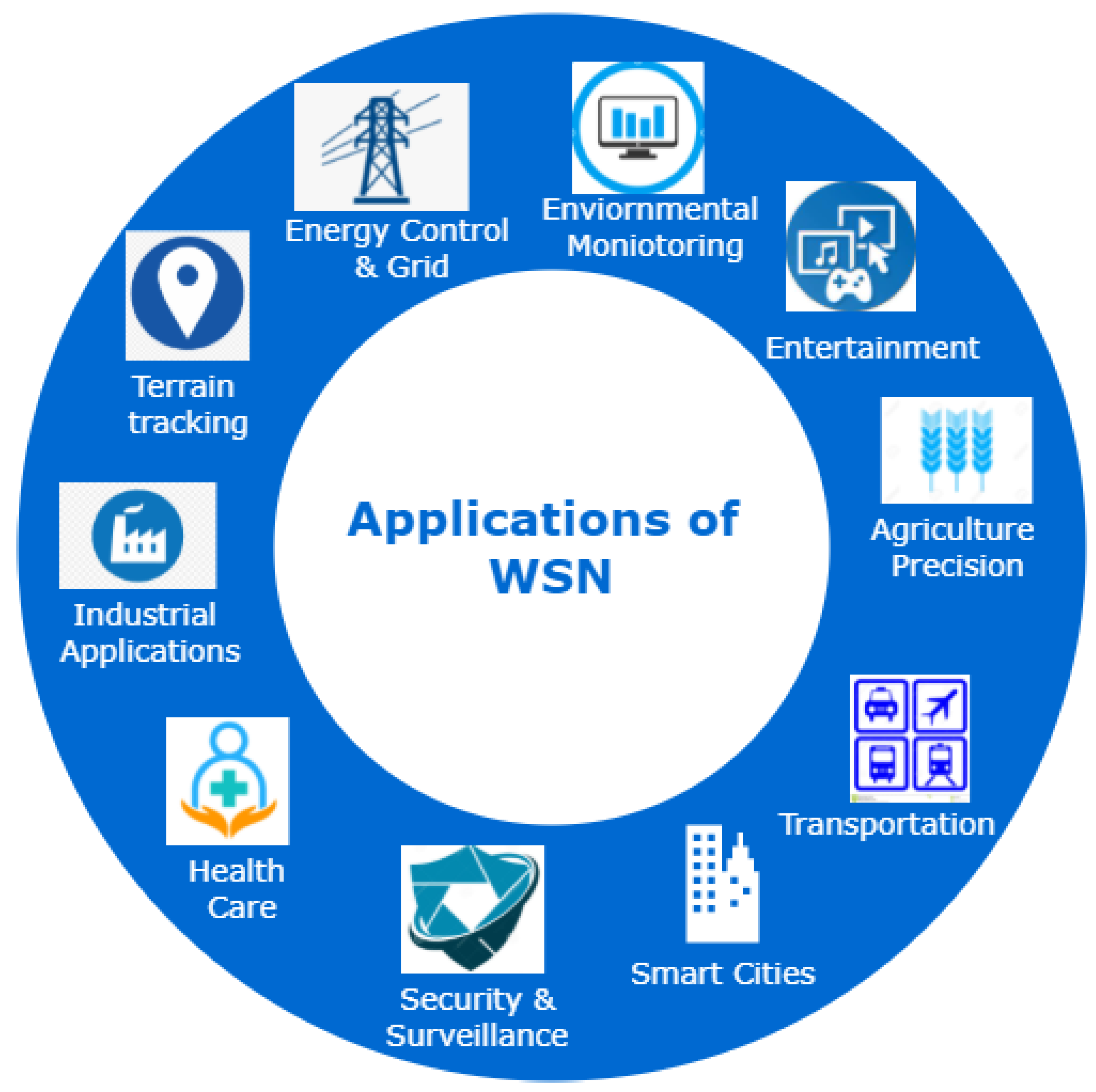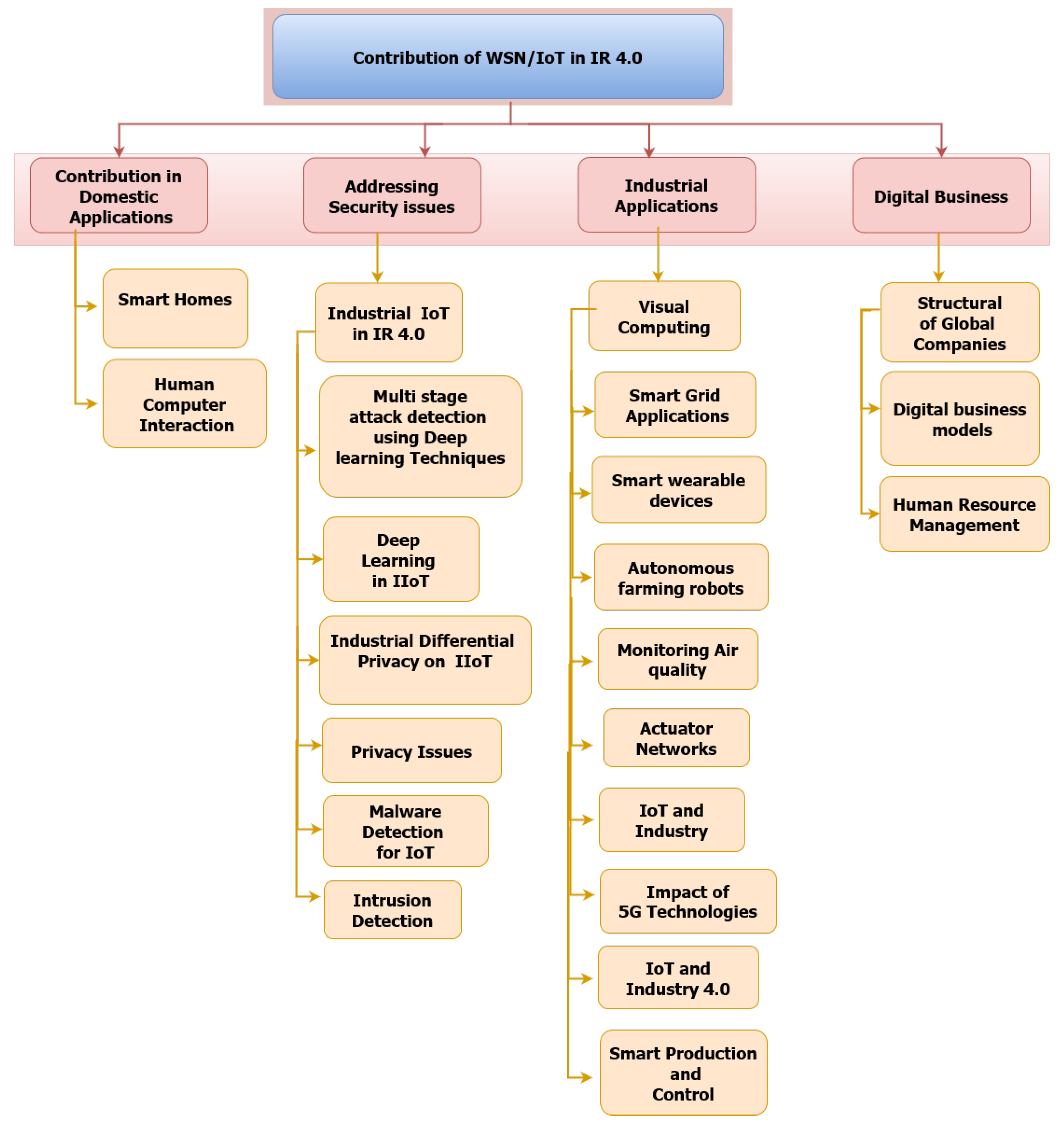RThis systesearchersmatic literature review offers a wide range of information on Industry 4.0, finds research gaps, and recommends future directions. Seven research questions are addressed in this article: (i) What are the contributions of WSN in IR 4.0? (ii) What are the contributions of IoT in IR 4.0? (iii) What are the types of WSN coverage areas for IR 4.0? (iv) What are the major types of network intruders in WSN and IoT systems? (v) What are the prominent network security attacks in WSN and IoT? (vi) What are the significant issues in IoT and WSN frameworks? and (vii) What are the limitations and research gaps in the existing work? ResearchersThis study mainly focuses on theresearch solutions and new techniques to automate Industry 4.0 and. In this research, we analyzed over 130 articles from 2014 until 2021. The entryis paper covers several aspects of Industry 4.0, from the designing phase to security needs, from the deployment stage to the classification of the network, the difficulties, challenges, and future directions.
- Internet of Things (IoT)
- industrial revolution 4.0 (IR 4.0)
1. Introduction

2. Contributions of IoT in IR 4.0

References
- Ravi, C.; Tigga, A.; Reddy, G.T.; Hakak, S.; Alazab, M. Driver Identification Using Optimized Deep Learning Model in Smart Transportation. ACM Trans. Internet Technol. 2020.
- Tandale, U.; Momin, B.; Seetharam, D.P. An empirical study of application layer protocols for IoT. In Proceedings of the International Conference on Energy, Communication, Data Analytics and Soft Computing (ICECDS), Chennai, India, 1–2 August 2017; pp. 2447–2451.
- Kumar, R.; Kumar, P.; Srivastava, G.; Gupta, G.P.; Tripathi, R.; Gadekallu, T.R.; Xiong, N.N. PPSF: A privacy-preserving and secure framework using blockchain-based machine-learning for IoT-driven smart cities. IEEE Trans. Netw. Sci. Eng. 2021, 8, 2326–2341.
- Farsi, M.; Daneshkhah, A.; Hosseinian-Far, A.; Jahankhani, H. (Eds.) Digital Twin Technologies and Smart Cities; Springer: Berlin/Heidelberg, Germany, 2020.
- Majeed, M.A.A.; Rupasinghe, T.D. Internet of things (IoT) embedded future supply chains for Industry 4.0: An assessment from an ERP-based fashion apparel and footwear industry. Int. J. Supply Chain. Manag. 2017, 6, 25–40.
- Oliff, H.; Liu, Y. Towards Industry 4.0 Utilizing Data-Mining Techniques: A Case Study on Quality Improvement. Procedia CIRP 2017, 63, 167–172.
- Ovsthus, A.A.K.S.K.; Kristensen, L.M. An Industrial Perspective on Wireless Sensor Networks—A Survey of Requirements, Protocols, and Challenges. IEEE Commun. Surv. Tutor. 2014, 16, 1391–1412.
- Muneeba, N.; Javed, A.R.; Tariq, M.A.; Asim, M.; Baker, T. Feature engineering and deep learning-based intrusion detection framework for securing edge IoT. J. Super Comput. 2022, 1–15.
- Osterrieder, P.; Budde, L.; Friedli, T. The smart factory as a key construct of Industry 4.0: A systematic literature review. Int. J. Prod. Econ. 2020, 221, 107476.
- Devesh, M.; Kant, A.K.; Suchit, Y.R.; Tanuja, P.; Kumar, S.N. Fruition of CPS and IoT in Context of Industry 4.0. In Intelligent Communication, Control and Devices; Springer: Singapore, 2020; pp. 367–375.
- Saniuk, S.; Grabowska, S.; Gajdzik, B. Social expectations and market changes in the context of developing the Industry 4.0 concept. J. Sustain. 2020, 12, 1362.
- Deepa, N.; Pham, Q.V.; Nguyen, D.C.; Bhattacharya, S.; Prabadevi, B.; Gadekallu, T.R.; Pathirana, P.N. A survey on blockchain for big data: Approaches, opportunities, and future directions. Future Gener. Comput. Syst. 2022, 131, 209–226.
- Number of Internet of Things (IoT) Connected Devices Worldwide from 2019 to 2030. 2021. Available online: https://www.statista.com/statistics/1183457/iot-connected-devices-worldwide/ (accessed on 21 January 2022).
- Jovanović, B. Key IoT Statistics. 2021. Available online: Https://dataprot.net/statistics/iot-statistics/ (accessed on 20 December 2021).
- AI Multiple. 30 Internet of Things—IoT Stats from Reputable Sources in 2021. Available online: https://research.aimultiple.com/iot-stats/ (accessed on 21 February 2022).
- O’Dea, S. Wide-Area and Short-Range IoT Devices Installed Base Worldwide 2014–2026. 2021. Available online: Https://www.statista.com/statistics/1016276/wide-area-and-short-range-iot-device-installed-base-worldwide/ (accessed on 14 December 2021).
- Lange, S. Digitalization, and energy consumption. Does ICT reduce energy demand? J. Ecol. Econ. 2020, 176, 106760.
- Müller, J.M. Fortune favors the prepared: How SMEs approach business model innovations in Industry 4.0. Technol. Forecast. Soc. Change 2018, 132, 2–17.
- Masood, T.; Sonntag, P. Industry 4.0: Adoption challenges and benefits for SMEs. J. Comput. Ind. 2020, 121, 103261.
- Zhu, J. Measurement and analysis of corporate operating vitality in the age of digital business models. Appl. Econ. Lett. 2020, 27, 511–517.
- Serror, M.; Hack, S.; Henze, M.; Schuba, M.; Wehrle, K. Challenges and Opportunities in Securing the Industrial Internet of Things. IEEE Trans. Ind. Inform. 2021, 17, 2985–2996.
- Li, X.; Xu, M.; Vijayakumar, P.; Kumar, N.; Liu, X. Detection of low-frequency and multi-stage attacks in industrial internet of things. IEEE Trans. Veh. Technol. 2020, 69, 8820–8831.
- Akram, Z.; Majid, M.; Habib, S. A Systematic Literature Review: Usage of Logistic Regression for Malware Detection. In Proceedings of the International Conference on Innovative Computing (ICIC), Seoul, Korea, 9–10 November 2021; pp. 1–8.
- Azmoodeh, A.; Dehghantanha; Choo, K.K.R. Robust malware detection for Internet of (battlefield) Things devices using deep eigenspace learning. IEEE Trans. Sustain. Comput. 2019, 4, 88–95.
- Khalil, R.A.; Saeed, N.; Masood, M.; Fard, Y.M.; Alouini, M.-S.; Al-Naffouri, T.Y. Deep learning in the industrial internet of things: Potentials, challenges, and emerging applications. IEEE Internet Things J. 2021, 8, 11016–11040.
- Jiang, B.; Li, J.; Yue, G.; Song, H. Differential privacy for Industrial Internet of Things: Opportunities, applications and challenges. IEEE Internet Things J. 2021, 8, 10430–10451.
- Ahmed, A.; Javed, A.R.; Jalil, Z.; Srivastava, G.; Gadekallu, T.R. Privacy of Web Browsers: A Challenge in Digital Forensics. In Proceedings of the International Conference on Genetic and Evolutionary Computing, Jilin, China, 21–21 October 2021; Springer: Singapore, 2021; pp. 493–504.
- Vangala, A.; Das, A.K.; Kumar, N.; Alazab, M. Smart secure sensing for IoT-based agriculture: Blockchain perspective. IEEE Sensors J. 2021, 21, 17591–17607.
- Maddikunta, P.K.R.; Pham, Q.V.; Prabadevi, B.; Deepa, N.; Dev, K.; Gadekallu, T.R.; Liyanage, M. Industry 5.0: A survey on enabling technologies and potential applications. J. Ind. Inf. Integr. 2021, 100257.
